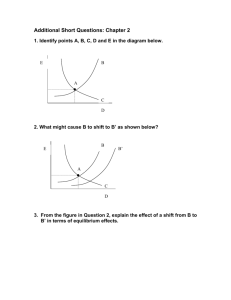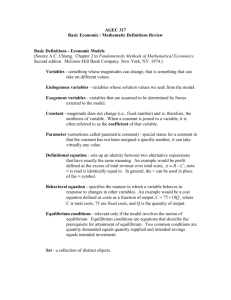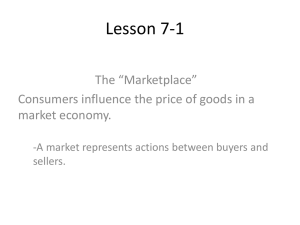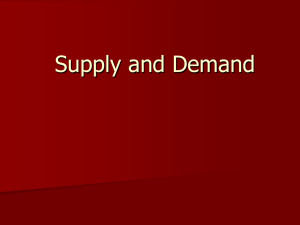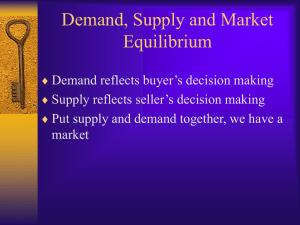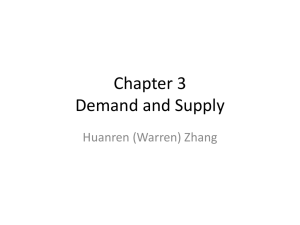Functions and Mathematical Models
advertisement
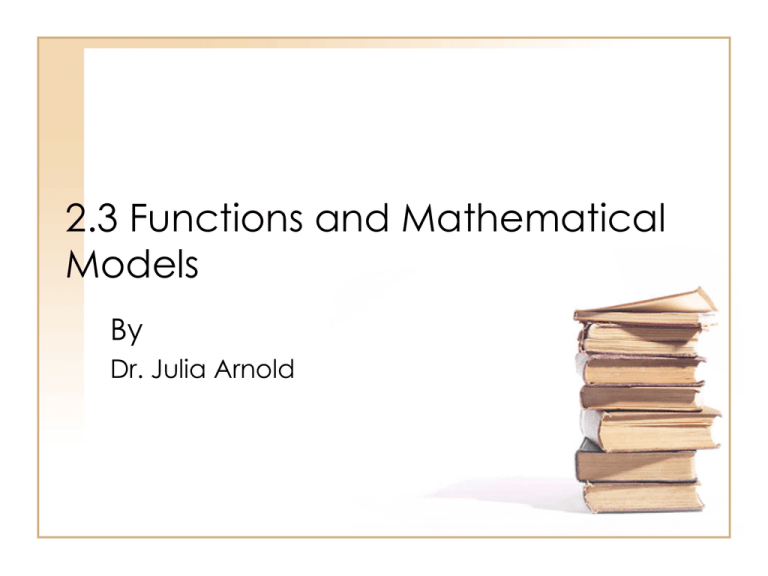
2.3 Functions and Mathematical Models By Dr. Julia Arnold A mathematical model is a mathematical representation of a real-world problem. Some problems may approximate a linear function: y = mx + b Others may be better approximated by some polynomial function or power function such as our Cost function in lesson 2.2 While still others may require a rational function such as the model for driving costs based on 1992 model compact cars which was found to be C(x) = 2095 20 . 08 x 2 .2 Economic Models A demand equation expresses the relationship between the unit price and the quantity demanded. The graph of the demand equation is called a demand curve. For example: At Christmas time the demand for certain popular items sometimes exceeds the manufacturer’s ability to provide them. Remember the wii? The equation that expresses the relation between the unit price and the quantity supplied is called a supply equation and its graph is called a supply curve. If the wii starts saturating the market, maybe it will cost below the $199 sales tag it has right now. This will mean that the supply is sitting on the shelf and is not being demanded by the consumer. Market equilibrium prevails when the quantity produced is equal to the quantity demanded and the corresponding price is called the equilibrium price. If the wii keeps selling out as the store keeps restocking then there is an equilibrium between supply and demand. For the demand equations where x represents the quantity demanded in units of a thousand and p is the unit price in dollars, a) sketch the demand curve and b) determine the quantity demanded when the unit price is set at $p. 2 p x 36 ; p 11 y This side represents negative x values which would be invalid. Only this number would be our solution. 2 11 x 36 2 x 25 x 5 5,000 since X is in units of A thousand. Blue line is p = 11 x Assume that the demand function for a certain commodity has the form p 2 ax b , a 0 , b 0 where x is the quantity demanded, measured in units of a thousand and p is the unit price in dollars. Suppose the quantity demanded is 6000 (x = 6) when the unit price is $8 and 8000 (x = 8) when the unit price is $6. Determine the demand equation. What is the quantity demanded when the unit price is set at $7.50? Assume that the demand function for a certain commodity has the form 2 p ax b , a 0 , b 0 where x is the quantity demanded, measured in units of a thousand and p is the unit price in dollars. Suppose the quantity demanded is 6000 (x = 6) when the unit price is $8 and 8000 (x = 8) when the unit price is $6. Determine the demand equation. What is the quantity demanded when the unit price is set at $7.50? 2 8 36 a b 64 36 a b 64 36 a b 2 6 64 a b 36 64 a b 36 64 a b 8 a (6 ) b 6 a (8 ) b 64 36 a 36 64 a 28 28 a 1a 64 + 36(1) = b 100 = b p 2 x 100 7 .5 2 x 100 2 56 . 25 x 100 2 x 43 . 75 x 6 . 614 6 , 614 units For each pair of supply and demand equations where x represents the quantity demanded in units of a thousand and p the unit price in dollars, find the equilibrium quantity and the equilibrium price. 2 p x 2 x 100 p 8 x 25 For each pair of supply and demand equations where x represents the quantity demanded in units of a thousand and p the unit price in dollars, find the equilibrium quantity and the equilibrium price. 2 p x 2 x 100 p 8 x 25 2 8 x 25 x 2 x 100 2 x 10 x 75 0 2 x 10 x 75 0 x 15 x 5 0 x 15 , x 5 Since -15 would not make sense, the equilibrium quantity is 5000 and the equilibrium price is 8(5)+25=$65
